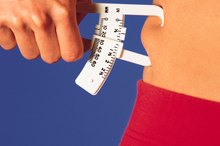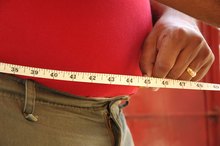How to Calculate Accurate BMI for Large Frame
BMI is an acronym that stands for Body Mass Index. The BMI is a measurement of body fat based on height and weight for adult men and women. Of course, this measurement must be adjusted accordingly for the large framed person to ensure accuracy. Note that the purpose of these measurements is merely to assess healthy parameters for your personal weight management. These numbers do not take into account muscle density or mass which can increase your health and vitality yet contribute to a heavier body weight and reflect a higher BMI.
Calculating Your BMI
Write down your current body weight in pounds.
How Much Should a Man Weigh?
Learn More
Write down your current height in inches. For example, a person who is 5 feet 3 inches tall has a total height in inches of 63.
Multiply the number in Step 2 by itself. For example if your height is 63 inches: 63 x 63 = 3969
How to Calculate Body Fat Into Pounds
Learn More
Divide your weight in pounds by the number in Step 3. For example, if you weigh 145 pounds:
145 ÷ 3969 = 0.036
Multiply the product in Step 4 by 703. For example:
.036 x 703 = 25.3
- Write down your current body weight in pounds.
- For example if your height is 63 inches: 63 x 63 = 3969 Divide your weight in pounds by the number in Step 3.
Determining Your Frame Size
Use the tape measure to measure your wrist in inches.
Assess your frame size according to the following chart:
WOMEN Under 5'2" – Large frame means a wrist size over 5.75" 5'2"-5'5" – Large frame means a wrist size over 6.25" 5'5" or greater – Large frame means a wrist size over 6.5"
MEN: over 5'5" – Large frame means a wrist size over 7.5"
If you have determined that you have a large frame, add 10 percent. This means that the healthy BMI for a person with a large frame is roughly 23-25.
Tips
Here is a BMI chart to which you should add 10 percent for a large frame:
BMI Below 18.5 = Underweight
BMI 18.5 to 24.9 = Normal
BMI 25.0 to 29.9 = Overweight
BMI 30.0 and above = Obese
Related Articles
References
Resources
Tips
- Here is a BMI chart to which you should add 10 percent for a large frame:
- BMI Below 18.5 = Underweight
- BMI 18.5 to 24.9 = Normal
- BMI 25.0 to 29.9 = Overweight
- BMI 30.0 and above = Obese
Writer Bio
Sala Saran is a bi-athlete and certified personal fitness trainer who is passionate about the life-transformative power of sports and fitness. Teaching a holistic perspective of the fitness lifestyle that is rooted in personal development, Saran shares her expertise in articles, columns and seminars to lead others to a discovery of their own power to transform their life experience.









